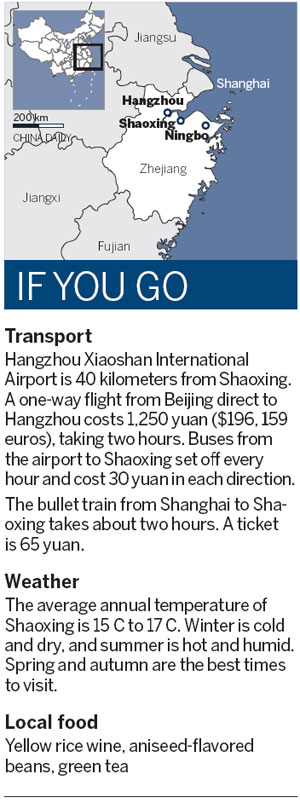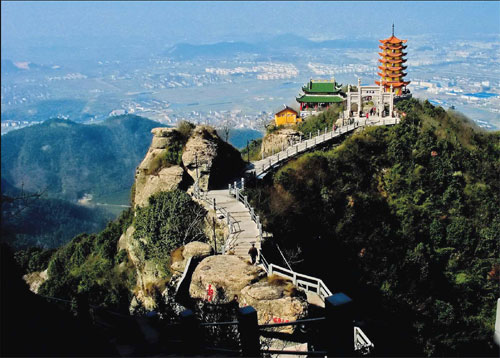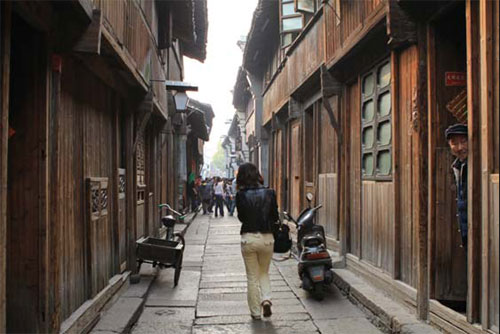Timeless appeal
Updated: 2012-08-24 09:17
(China Daily)
|
|||||||||||
|
Kuaiji Mountain is the birthplace of China's first dynasty. Photos provided to China Daily |
For almost two millennia, Shaoxing has been renowned for its culture and natural beauty
Chinese people use the phrase "cities of fish and rice" to describe the places south of the Yangtze River. There are huge grain plantations and waters that can produce aquatic foods. Shaoxing, in the northwestern part of Zhejiang province, is one such place.
It was one of the richest Chinese cities in the Western Jin Dynasty (AD 265-316), and even in the industrialized modern world Shaoxing is still the center of China's textile industry. Situated to the east of Hangzhou and the west of Ningbo, it is a two-hour drive from two of the most developed cities in Zhejiang.
But do not assume that Shaoxing's economic development has erased its natural beauty. It is still as pretty as a painting, and visitors can travel along Shaoxing's waterways in a wooden boat, listening to the boatman singing traditional songs.
Here are some places worth visiting:
1. Kuaiji Mountain

This mountain is six kilometers southeast of downtown Shaoxing. It is the birthplace of China's first dynasty, the Xia Dynasty (c.21st century-16th century BC). Kuaji Mountain is considered a sacred peak.
Yu, the first emperor of the Xia Dynasty, was married, crowned and buried at this mountain. His tomb, which can be visited today, is an illustration of the grand style of ancient Chinese architecture.
When visiting the mountain, travelers can hear many birds singing. The mountain is the site of the largest bird population and numbers of species in China.
There are devices enabling people to "talk" to birds, and visitors can also watch birds perform. At the top of Kuaiji Mountain, a 1,280-meter ski path awaits visitors. Allowing speeds of up to 60 kilometers per hour, the path is the first of its kind in Zhejiang.
2. Keyan scenic port
Scenic Keyan has been famous for its rocks, waterways and caves for more than 1,800 years. Its iconic rock, Yungu, is more than 30 meters tall, but its base is no more than 4 square meters. There is a 1,000-year-old cypress at the top of the rock.
Yuanshan Garden contours to the mountain's terrain. It is the largest garden of Tang Dynasty (AD 618-907) style in China. Many rocks were used in its construction, reflecting Keyan's craggy beauty.
In Shaoxing, where there is a mountain there is a lake, and Keyan is no exception. Jianhu Lake is another of Keyan's main scenic spots. Li Bai, one of the greatest poets in Chinese history, once wrote that the water of Jianhu Lake is as smooth and bright as the moon.
Visitors can also hear Yueju Opera, China's second-largest traditional opera, while sitting on a boat on a lake, with the mountain and the rocks around them.
3. Lanting Pavilion
Chinese calligraphy is one of the traditional arts that are recognized worldwide. Lanzhu Mountain, where Lanting Pavilion is located, was once the residence of Wang Xizhi, one of China's greatest calligraphy artists. Lanting Pavilion is where Wang created some of his celebrated calligraphy pieces and has become a sacred site.
The pavilion is hidden in the mountains, surrounded by trees and bamboo. A brook runs through the area. When visitors are sitting quietly in the pavilion, the sounds of breezes, falling leaves and the running brook can all be enjoyed. For more than 1,500 years, Lanting Pavilion has been a gathering place for people who love calligraphy and enjoy the peace of the natural world.
4. Lu Xun's former residence
Lu Xun, whose real name is Zhou Shuren, was a 20th-century novelist, revolutionary and thinker. His masterpieces appear in the textbooks of Chinese primary and middle schools. Shaoxing, his hometown, was where he lived until his teens.
His former residence in Shaoxing is the best-preserved block in the downtown area. On either side of the narrow street are the house where his grandparents used to live, and the houses where Lu Xun used to live and study, as well as his family's gardens. It easily reminds people of similar scenes in his novels.
Lu Xun's old house is a two-story wooden dwelling. Some of the old furniture is still there, so visitors can get an insight into the early life of China's greatest contemporary writer.
Eating and drinking
Xianheng Restaurant is a must-go. Beans flavored with aniseed is the favorite snack for Shaoxing residents to eat with wine. The city is famous for its yellow rice wine, which is referred to as huangjiu in Chinese. The amber-colored wine is made from glutinous rice. When the wine is hot and you take a sip, the mild liquid flows easily down your throat while its natural taste remains in your mouth.
Shaoxing residents' fondness for wine can be seen in their food. Braised chicken with wine, crabs with wine and shrimp with wine are all famous local dishes. And while you are dining in Shaoxing, the pork with dry cabbage cannot be missed.
China Daily
|
Lu Xun's former residence in Shaoxing is the best-preserved block in the downtown area. Photos provided to China Daily |
Today's Top News
President Xi confident in recovery from quake
H7N9 update: 104 cases, 21 deaths
Telecom workers restore links
Coal mine blast kills 18 in Jilin
Intl scholarship puts China on the map
More bird flu patients discharged
Gold loses sheen, but still a safe bet
US 'turns blind eye to human rights'
Hot Topics
Lunar probe , China growth forecasts, Emission rules get tougher, China seen through 'colored lens', International board,
Editor's Picks

|

|

|

|

|

|







